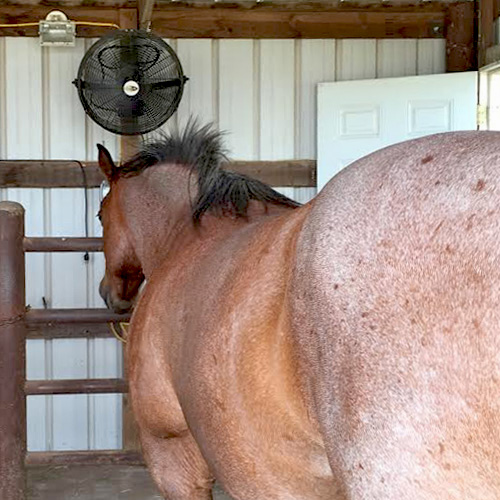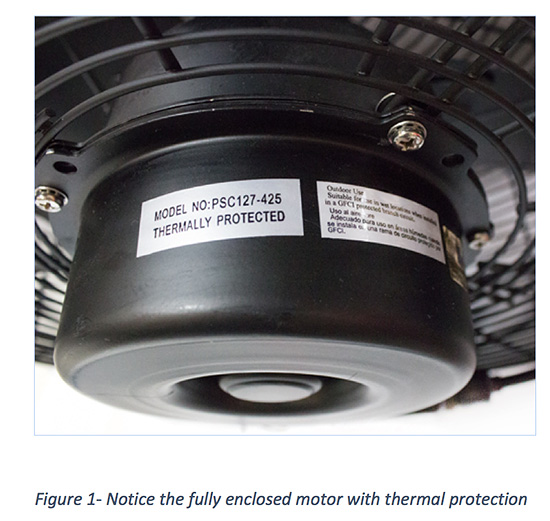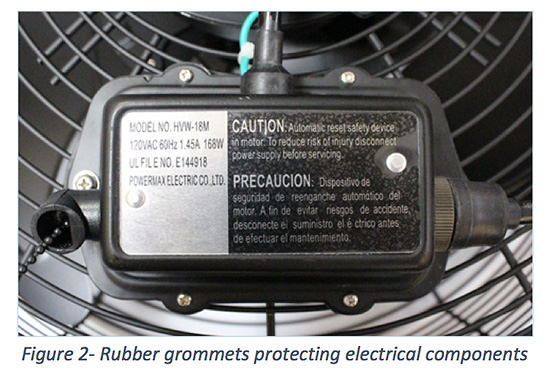|
The BEST Fan for Horse Stalls
 |
Most fans seen in barns are absolutely NOT designed to be in a barn (or any agricultural setting). So what is the big difference in fans? Here are a few of the crucial differences
between fans made for residential use versus agricultural use.
Article by Christy Schulthess
The air is still, making the sounds of the cicadas more prominent. It is hot, muggy. Yep – it’s summer. By this point we have
already broken out the fans in the barn, they have been running quite a bit for the past couple of months. They are probably a little
dusty by now, but they will be fine – they always have been…right? Don’t make the mistake that so many barn owners have.
Unless those fans are specifically rated for agricultural use, they are NOT safe!
We’ve all seen it – plastic box fans strapped to the front of a stall front. Or, suspended above the stall with a mounting device
available through any online equestrian retailer. It would appear, based on the fact that fellow horse enthusiasts are selling them for barn use that they must be safe. They are not…
The problem becomes that these box fans (and many other "industrial" fans) are not designed to be in our barns. I've heard many
people proclaim - "I dust my fans, so they are safe!" The blades and guards are not the problem - if the motor is not enclosed and
the bearings not sealed, all that barn gunk WILL get inside of it. This causes friction. Friction causes heat and possibly fire. In 2007
, 44 horses were killed in a fire caused by new box fans.
On this point we do a disservice to each other. Whether it is at a major farm retail store or through the many online stores, fans are
sold to unsuspecting horse owners that are not designed to be in a barn. Catchy words and phrases such as “industrial,” “high
velocity’” and “weatherproof” are designed to lure us in. In actuality, however, these fans are most often not suited for any
agricultural use. Indeed, there are sometimes explicit disclaimers located in the operating manual stating just that.
Most fans seen in barns are absolutely NOT designed to be in a barn (or any agricultural setting).
So what is the big difference in fans? There are a few crucial differences between fans made for residential use versus agricultural use:
 |
1)Full enclosed motors featuring sealed ball bearings. Residential fans are vented. The motor parts are exposed to dust and dirt.
This can build up in the electrical housing causing a fire.
2)Thermostatic overload shutoff switch. If the fan overheats it will automatically shut off, preventing enough heat buildup which may cause a fire.
3)UL507 certified motor. This means that the electrical device is rated for outdoor use – it can get wet. In wash bays these fans can safely be used and even sprayed down to clean them off.
 |
In addition to the three safety points listed above, you will want to consider that bigger is not always better. CFM is the rating for
how much air a fan moves. Many industrial or high velocity fans (even if they have at least points 1& 2 above covered) are really not
best suited for barn use. They move TOO much air. Think about how much dust can be kicked up if there is basically a jet engine
pointed into a stall. Fans up to about 2,250 CFM are best in a barn.
You also may consider what happens if you did have a fire caused by a box fan (or any other non-agriculturally rated electrical
appliance). Will you insurance cover a claim if the item which caused the fire was not rated for use in the barn? It’s something to ask your agent, to be sure.
Many of you are thinking by now… I’ve used my box fans for years. I’ve seen them in use at hundreds of facilities. I’m safe. So
did this gal… Luckily she caught it in time and nothing was too badly damaged. In her words “all because of a stupid box fan.”
So where are these “majikal” unicorn fans to be found? Up to 2,210 CFM, enclosed motor, sealed ball bearings, thermally regulated
, and wash down safe. (Use common sense when washing them off – please don’t use a pressure washer on “high” that may break
the seals!). We also offer a 24” wall mount oscillating fan with the same safety specifications. Best of all, we offer a misting option
that can be incorporated with these fans for additional cooling.
Yes, agricultural fans are much more expensive than the $20 box fan. In response to this remark on our Facebook page, a follower
wrote this, "I understand the concern about cost but I will say I bit the bullet and bought the sealed motor fans years ago. I was tired
of constantly having to replace box fans because they didn't last. They [the sealed motor fans] last 10-15 times longer even in the
deep south under constant use. So given the time and cost savings of always having to shop and replace them and the safety factor they are well worth the cost."
|